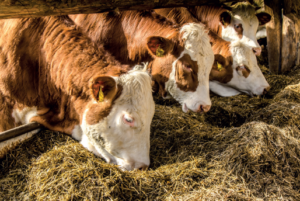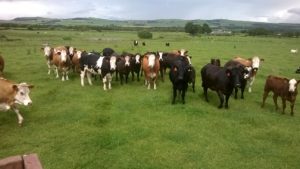Nutrition
Nutrition is an essential element to successful beef and sheep systems. Cattle are ruminants, meaning they can gain essential nutrients from grass. They have a rumen, which is home to bacteria and protozoa called microbes. These microbes break down the forage and cereals eaten by livestock, including the cellulose, hemicellulose, protein and starch. In the digestive tract, there is a smaller organ, called the reticulum, an omasum and an abomasum (true stomach).
Ensuring both ruminants and monogastric animals are being offered a suitable ration for their age, growth potential, time of production cycle, time of year, etc. is very important. The feed requirement, will be specific to each class of animal, deepening on the production and growth. Three main areas to look at for feed requirement is energy, protein and minerals/vitamins.
The requirements vary largely depending on the stage they are in production e.g. growing, pre calving, etc.
Nutrition is required for maintenance of the animal, growth, fertility, milk production and health. Condition scoring animals on a regular basis is the best way to ensure the nutrition being offered is meeting their demands for the stage in production.

Cattle Mineral Supplementation
Throughout the year and production cycle, the cow goes through different phases with varying nutritional requirements depending on her stage of production. Minerals are an essential part of a cow’s diet, important for growth, productivity, and immunity. It is vital that supplementation of minerals takes place at the correct time and quantity throughout the cycle to ensure that the cow’s requirements are met. Read more >>
Technical Note - Treatment To Grain For Feeding Ruminants
This technical note outlines the options for preserving early harvested and conventionally harvested cereal crops. Some options also enhance nutritional quality of the cereals. Read more>>
Nutritional Management and Metabolic Profiling of Suckler Cows
Feeding For Fertility In The Suckler Herd
This Scottish Government funded project report details work involving 12 suckler herds where cow nutritional status was investigated by metabolic profiling over the 2020 calving period. Cows were blood sampled one month pre- and post-calving to identify whether energy, protein and mineral intakes were adequate. Information was also gathered on body condition score change and rations to help assess nutritional status and whether this could be linked to subsequent reproductive performance. Read more>>
Mineral Requirements in Housed Cattle
Minerals are vital for the cow to function as they are important in several processes within the body which support health and performance. Minerals are required at every stage of life, whether it is growth during youngstock, fertility in heifers and cows, milk production or growth of a foetus during pregnancy. It is important to get the optimum mineral status correct for the cow to be as productive and healthy as possible. Read more >>
Ruminant Nutrition and Forage Analysis
In order to get the best performance from ruminants it is helpful to know the primary functions of their specialised digestive system. Firstly, there are many different species of ruminant animals including cattle, sheep, goats, deer and buffalo. Ruminants can digest forages and fibrous roughages that monogastric’s (e.g. humans, pigs and poultry) can’t. Ruminants have evolved a special system of digestion that involves microbial fermentation of food before it is then exposed to their own digestive enzymes. Read more>>
Fodder Beet
We have a series of webinars, podcasts and technical information on the growing and feeding of fodder beet for beef, dairy and sheep. Read more>>
Mineral Nutrition For Beef Cattle
Water, energy and protein are essential for survival and performance and make up the biggest proportion of the ration. Minerals and vitamins are required in relatively small amounts. These are vital components that allow chemical reactions in the body to take place. Each has a different function within the body, such as catalysts which drive metabolic processes or components of cell division for growth. Therefore, they are a necessary part of the ration and are important for good growth, fertility, health and immunity. Read more>>
Technical Note - Forage Crops For Livestock
Forage crops offer an excellent solution to filling the forage gap in the autumn and winter months when grass growth slows down. They integrate well with grassland and livestock, aiding in controlling a surplus of spring and summer grass and offering a high yielding, quality feed for the autumn and winter months. Read more>>
Mob Grazing Beef Cattle
Mob grazing with beef cattle can reduce housing cost, improve soil structure and improve pasture productivity long term. This factsheet gives an overview of what it involves and how to get started. Read more>>
Rotational Grazing
Rotational grazing is a great tool for new entrants as well as established farmers, as it enables greater stocking densities. Those with fewer opportunities to gain more land, or using seasonal lets, can expand flock or herd size through better grassland utilisation – rotationally grazed grass is better utilised grass. Read more>>
Supplying Water to Rotationally Grazed Beef Cattle
Designing an effective rotational grazing system involves ensuring a reliable supply of clean drinking water for livestock across multiple paddocks or pastures. This system must withstand weather extremes and ensure continuous access to water, as lack of access can cause stress and impact animal performance. Read more>>
Understanding Feed For Beef Cattle And Sheep
With good nutrition, animals are healthier and more of their genetic potential can be achieved. Nutrition is the biggest driver of flock or herd performance. This practical guide will give you the key points for successful feeding, including:
- Important terms
- How to analyse feed labels
- Tests and tools
Technical Note - Trace Element Deficiencies In Beef Cattle
Trace elements are minerals that in small quantities are essential for the normal health and function of animals. In Britain the trace elements that may be limiting are copper, cobalt, selenium and iodine. The absence of deficiecny of these elements can result in ill-thrift or reproduction failure, however when supplied to excess poisoning can occur. Read more>>
Forage & Feeds: Assessing Forage Stocks
This video is the first in our winter feed planning series covering assessing your forage stocks and their quality, as well as what to do if you are short.
Karen Stewart takes a look at how to assess silage stocks and the importance of making a plan. View here>>
Forage & Feeds: Assessing Your Forage - Part 1
Mary Young takes us through the importance of analysing the silage on your farm and how to make the most of your home grown forage. View here>>
Forage & Feeds: Assessing Your Forage - Part 2
Forage & Feeds: Formulating Rations
Ration planning saves time and money, Mary Young takes us through how to make the most of the feed you have on farm and what you need to buy in. View here>>
Forage & Feeds: Assessing The Ration
As well as ration formulation there are many environmental factors to consider in making winter feeding a success, this short video talks us through what to check. View here>>
Forage & Feeds: Dealing With A Forage Shortage
If you think you might be short of forage this winter take action early, here is a short video of some handy tips. View here>>
Industry Links
Sign up to the FAS newsletter
Receive updates on news, events and publications from Scotland’s Farm Advisory Service




















